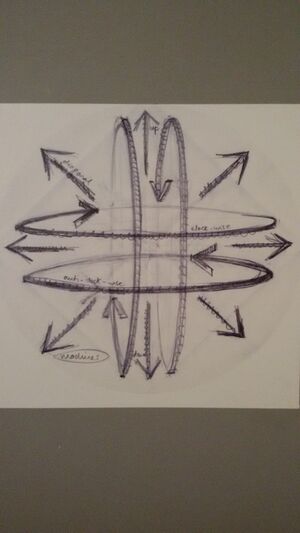Dimensions
Chapter 1 - Worldview
Previous page: Actions - Dimensions - Next page: Directions
Back to Book or directly to Main Page
.
Welcome to the Dimensions page
.
- Dimensions are guiding metaphors for the complex reality that we are and our context is. They structure the totality of our world of experiences
Direction provides the 'expansiveness' of your world model
Hidden layers are fields created by the 'action' and 'evaluation' dimension
On top, all layers together create the third 'potential' dimension
.
Core idea
.
What are dimensions?
- A measure of spatial extent: magnitude, proportion, size, scope
- A construct whereby objects or individuals can be distinguished: attribute, property
.
Dimensional properties
.
.
- We live in a world in which we can model our actions at a conceptual level on 3 dimensions:
- Action dimension (from autonomy to participation)
- Evaluation dimension (from coherence to conectedness)
- Potention dimension (from competences to relevance)
- Each of them is everything between two (paradoxical) extremities (see next page, directions)
- Together they shape the totality of our world
.
Dimensions don't 'exist as described and drawn' here. It is only a 'representation'. The dimensions on the drawings are deliberately not drawn straight to give shape to the capriciousness of human nature.
.
Dive deeper
.
To define 'dimensions' we rely heavily on the work of Peter Godfrey-Smith and Daniel Dennett on Darwinian space. What we call here the action dimension, Peter Godfrey-Smith calls the H-dimension. The evaluation dimensions he calls the C-dimensions, and the relevance dimension the S-dimension.
.
First - Action dimension
.
From "What is important to me" (AUTONOMY) to "What is important for us" (PARTICIPATION)
.
- This dimension indicates our importance to life (our ability to reproduce), creating patterns.
- It captures the tension between our interests and our interest in being part of our group and, by extension, of humanity.
.
| Darwinian space core concept: 'Heritability' |
|---|
| The dimension, H, is an analogue of the conventional concept of heritconcept, is independent of genetics. (Darwin had no theory of genetics; he only required some degree of correlation of characters between parents and offspring.) |
.
Second - Evaluation dimension
.
From "What has meaning to me" (COHERENCE) to "What is the meaning for us" (CONNECTEDNESS - INVOLVEMENT)
.
- This dimension captures how we evaluate the context around us for its usefulness in the first dimension, creating principles.
- Life created emotions to facilitate this process.
.
| Darwinian space core concept: 'The characteristics of individual agents' |
|---|
| The dimension, C, concerns the continuity of changes in fitness values with changes in characteristics (or phenotypes) of individuals. This roughly mirrors the ruggedness or smoothness of a fitness landscape, especially when the characters considered are genetic states of a population of organisms. |
.
Although the action and evaluation dimensions are distinct, they are inseparably linked biologically, neurologically, and culturally.
.
.
Third - Potential dimension
.
From "My competences" (COMPETENCES) to "The relevance of actions for the bigger situation" (RELEVANCE)
.
- This dimension arises from the bodily, cognitive, cultural, and contextual experiences that the two previous dimensions (action and evaluation) undergo over time.
- By combining the patterns with the principles, the bodily, cognitive, cultural, ..., context creates processes.
.
| Darwinian space core concept: 'Reproductive success' |
|---|
| The dimension, S, measures the dependence of reproductive success (‘realized fitness’) on ‘intrinsic’ versus ‘relational’ or ‘extrinsic’ characters of the parents. High S corresponds to reproductive success depending on intrinsic characters. This allows distinctions between ‘accidental’ success (one twin killed by lightning before reproducing, the other with numerous offspring) and success due to intrinsic features and is a crucial component of Godfrey-Smith’s novel analysis of genetic drift. |
.

